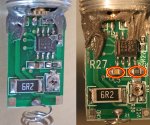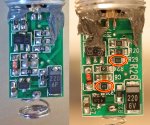Kage
0
- Joined
- Mar 5, 2008
- Messages
- 285
- Points
- 18
I got bored the other day and decided to try reverse-engineering the Dilda. The following PCB picts and the schematic are of the newer ones like those sold by O-like.com.
Here are the PCB picts with epoxy removed:


As near as I can determine, this is the schematic:

I have included voltage readings for a 7V input and Current adjusted to 300mA for troubleshooting purposes.
I learned a lot about this device while doing this.
- The earlier models may not regulate properly, but can easily be updated by changing a few resistors to make them like the newer models.
- Once updated and working properly, R1 - the large 6.2 ohm resistor can be replaced by a piece of wire to allow the Dilda to run in regulation from two 3.0V batteries like the cheap green ones sold by DX
- The pot can be adjusted for over 400mA to the Laser Diode when the unit is working right.
Q1 and U1 part numbers are my best guess - I am ordering some to test
Keep in mind this is a first try - there may be errors or omissions -
Edit:
Changed text above - I was calling the 6.2 - R27, but the schem shows it as R1. Oops :-?
Here are the PCB picts with epoxy removed:


As near as I can determine, this is the schematic:

I have included voltage readings for a 7V input and Current adjusted to 300mA for troubleshooting purposes.
I learned a lot about this device while doing this.
- The earlier models may not regulate properly, but can easily be updated by changing a few resistors to make them like the newer models.
- Once updated and working properly, R1 - the large 6.2 ohm resistor can be replaced by a piece of wire to allow the Dilda to run in regulation from two 3.0V batteries like the cheap green ones sold by DX
- The pot can be adjusted for over 400mA to the Laser Diode when the unit is working right.
Q1 and U1 part numbers are my best guess - I am ordering some to test
Keep in mind this is a first try - there may be errors or omissions -
Edit:
Changed text above - I was calling the 6.2 - R27, but the schem shows it as R1. Oops :-?







